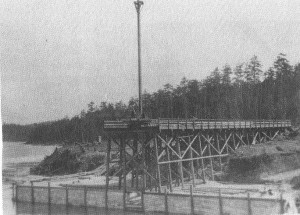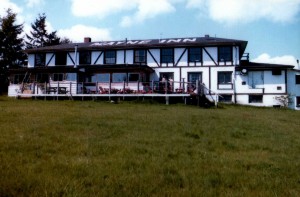History
A Brief History of The Mayne Inn


A search of title shows the property has been bought and sold more than thirty times over the last one hundred years and owned by many colorful characters. A few milestones are mentioned below.
![]() April 1st, 1892 the title for the property at the Mayne Inn was first registered from the Crown to Thomas Bennett. The Bennett’s owned and worked this property until 1910. The bay that the property borders became known as Bennett Bay.
April 1st, 1892 the title for the property at the Mayne Inn was first registered from the Crown to Thomas Bennett. The Bennett’s owned and worked this property until 1910. The bay that the property borders became known as Bennett Bay.

Brickworks Dock
![]() The title registry indicates that in 1910 the property was transferred to the Franco Canadian Brickworks Company. In 1911, The Franco Canadian Company began the construction of a brick works complex to develop the deposit of blue clay that runs from Bennett Bay inland for about one kilometre.
The title registry indicates that in 1910 the property was transferred to the Franco Canadian Brickworks Company. In 1911, The Franco Canadian Company began the construction of a brick works complex to develop the deposit of blue clay that runs from Bennett Bay inland for about one kilometre.
![]() The Infrastructure included a warehouse located north of the Inn in an area that is now part of the park reserve, a jetty type wharf located at the foot of Seaview Road for the purpose of loading barges with bricks, a kiln house built close to the barge landing, ore car rail tracks interconnecting the facility and a large Tudor-style boarding house that was built for the brick factory workers.
The Infrastructure included a warehouse located north of the Inn in an area that is now part of the park reserve, a jetty type wharf located at the foot of Seaview Road for the purpose of loading barges with bricks, a kiln house built close to the barge landing, ore car rail tracks interconnecting the facility and a large Tudor-style boarding house that was built for the brick factory workers.
![]() When World War I broke out the Brickworks closed as a result of the withdrawal of the European investment capital. The boarding house was fortunately maintained, periodically renovated and used as a commercial accommodation through the remainder of the century.
When World War I broke out the Brickworks closed as a result of the withdrawal of the European investment capital. The boarding house was fortunately maintained, periodically renovated and used as a commercial accommodation through the remainder of the century.

The Mayne Inn
![]() Initially called the Franco Canadian Boarding house, it was later renamed the Hollandia Lodge in the forties and fifties, the Arbutus Lodge in the sixties, the Mayne Hotel in the seventies and finally the Mayne Inn in the eighties until now. Rather than demolish this landmark Inn the developers decided to preserve this locally historic Inn as a center piece to the new Resort.
Initially called the Franco Canadian Boarding house, it was later renamed the Hollandia Lodge in the forties and fifties, the Arbutus Lodge in the sixties, the Mayne Hotel in the seventies and finally the Mayne Inn in the eighties until now. Rather than demolish this landmark Inn the developers decided to preserve this locally historic Inn as a center piece to the new Resort.
We hope you enjoy the character of this antique building, the original floors preserved under clear varathane and that you don’t get bothered too much by our mischievous but friendly resident spirits.
Mayne Island’s history
Originally, Mayne Island was inhabited by members of the Tsartlip First Nation, prior to European colonization. Several middens are present on the island, along with period articles most notably including a 2 tonne stone bowl.
In 1794 Captain George Vancouver camped on Georgina Point where his crew left a coin and a knife found over a century later by early settlers.
During the late 19th century Mayne Island was both the commercial and social centre of the Gulf Islands.
In 1857 Captain George Richards of the Royal Navy surveyed the area as captain of the Royal Navy vessel HMS Plumper, naming the island after his Lieutenant Richard Charles Mayne, son of the first commissioner of the London Metropolitan Police.
During the Fraser Canyon Gold Rush of 1858-1860 and after, Vancouver Island miners gathered on Mayne Island before rowing across Georgia Strait to the mainland of BC in search of their fortunes. The earliest homesteaders registered land claims in the Miners Bay area in 1859.
In 1900, it was the Pacific Northwest destination for adventurous tourists. As a result, it has an unusually large number of hotels and tourist facilities for an island of 1200 permanent residents.
In 1911, the Franco-Canadian Company built a brick plant at Bennett Bay. A large Tudor-style Inn accommodation was erected to accommodate the workers. Tracks were laid for ore cars and a kiln built near a concrete barge landing. World war 1 closed the operation when funds dried up from the French interests. The Tudor style building was then used as a hotel and comprises the majority of the structure and rooms at the Mayne Island Resort Inn building.
The port at Miners Bay was always busy due to the steady stream of marine traffic travelling through Active Pass, the narrow, curving strait separating Mayne from Galiano Island to the north, which is the main ferry route between the Mainland and Vancouver Island today. The historic village at Miners Bay remains the commercial centre of the island, with the annual Fall Fair still being held at the old Agricultural Hall like so many years before. Nearby Active Pass still throbs with a steady stream of marine traffic, a bustling contrast to the island’s quiet interior byways. Village Bay, with its BC Ferries terminal, has several late 19th century to 1930s buildings. Active Pass is named after the American survey ship USS Active, the first steam vessel to navigate the pass.
BC Ferries operates a vehicle and passenger scheduled ferry service from Tsawwassen (Vancouver) on the mainland and Swartz Bay (Victoria) on Vancouver Island. SeaAir Seaplanes operates a scheduled float plane service calling at Mayne Island from Vancouver downtown and the airport.
The Mayne Island community holds a Farmer’s Market every Saturday morning throughout the spring to autumn months. Here the Islanders sell their local produce, handicrafts, and art work.



